 W
WThe bean weevils or seed beetles are a subfamily (Bruchinae) of beetles, now placed in the family Chrysomelidae, though they have historically been treated as a separate family. They are granivores, and typically infest various kinds of seeds or beans, living most of their lives inside a single seed. The family includes about 4,350 species and are found worldwide.
 W
WCadra calidella, the dried fruit or date moth, is a species of snout moth in the genus Cadra and commonly mistaken for the species Cadra figulilella. It thrives in warmer conditions and is found primarily in Mediterranean countries, although it can also be found in Central Asia, Kazakhstan, Transcaucasia, Caucasus, and the western part of Russia. It feeds on dried fruits, carobs, nuts and seeds, hence earning its colloquial name. This diet damages the food industry, and it is a common storage pest. Because of this, much research has been done to study ways to limit its reproduction rate and population size. It was first described by Achille Guenée in 1845.
 W
WCallosobruchus maculatus is a species of beetles known commonly as the cowpea weevil or cowpea seed beetle. It is a member of the leaf beetle family, Chrysomelidae, and not a true weevil. This common pest of stored legumes has a cosmopolitan distribution, occurring on every continent except Antarctica. The beetle most likely originated in West Africa and moved around the globe with the trade of legumes and other crops. As only a small number of individuals were likely present in legumes carried by people to distant places, the populations that have invaded various parts of the globe have likely gone through multiple bottlenecks. Despite these bottlenecks and the subsequent rounds of inbreeding, these populations persist. This ability to withstand a high degree of inbreeding has likely contributed to this species’ prevalence as a pest.
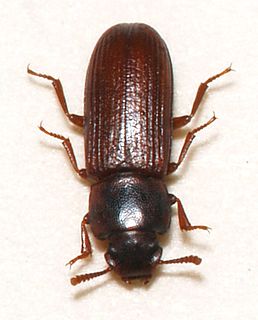 W
WThe confused flour beetle, a type of darkling beetle known as a flour beetle, is a common pest insect known for attacking and infesting stored flour and grain. They are one of the most common and most destructive insect pests for grain and other food products stored in silos, warehouses, grocery stores, and homes.
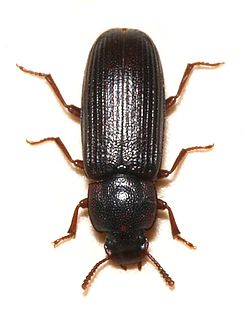 W
WThe destructive or dark flour beetle, one of the species of darkling beetle known generally as flour beetles, is a common pest insect known for attacking and infesting stored flour and grain.
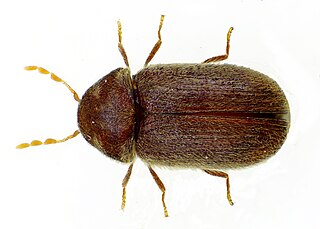 W
WThe drugstore beetle, also known as the bread beetle, biscuit beetle, and misnamed as the biscuit weevil, is a tiny, brown beetle that can be found infesting a wide variety of dried plant products, where it is among the most common non-weevils to be found. It is the only living member of the genus Stegobium.
 W
WFlour beetles are members of the darkling beetle genera Tribolium or Tenebrio. They are pests of cereal silos and are widely used as laboratory animals, as they are easy to keep. The flour beetles consume wheat and other grains, are adapted to survive in very dry environments, and can withstand even higher amounts of radiation than cockroaches. They are a major pest in the agricultural industry and are highly resistant to insecticides.
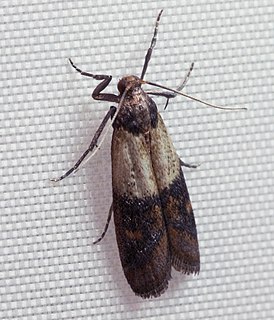 W
WThe Indianmeal moth, also spelled as Indian meal moth and Indian-meal moth, is a pyraloid moth of the family Pyralidae. Alternative common names are weevil moth, pantry moth, flour moth or grain moth. The almond moth and the raisin moth are commonly confused with the Indian-meal moth due to similar food sources and appearance. The species was named after being noted for feeding on Indian-meal or cornmeal and it does not occur natively in India as the aberrant usage of Indian meal moth would suggest. It is also not to be confused with the Mediterranean flour moth, another common pest of stored grains.
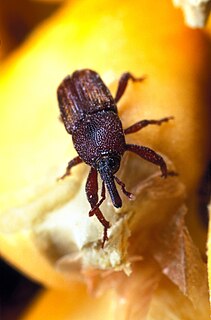 W
WThe maize weevil, known in the United States as the greater rice weevil, is a species of beetle in the family Curculionidae. It can be found in numerous tropical areas around the world, and in the United States, and is a major pest of maize. This species attacks both standing crops and stored cereal products, including wheat, rice, sorghum, oats, barley, rye, buckwheat, peas, and cottonseed. The maize weevil also infests other types of stored, processed cereal products such as pasta, cassava, and various coarse, milled grains. It has even been known to attack fruit while in storage, such as apples.
 W
WMealworms are the larval form of the mealworm beetle, Tenebrio molitor, a species of darkling beetle. Like all holometabolic insects, they go through four life stages: egg, larva, pupa, and adult. Larvae typically measure about 2.5 cm or more, whereas adults are generally between 1.25 and 1.8 cm in length.
 W
WThe Mediterranean flour moth or mill moth is a moth of the family Pyralidae. It is a common pest of cereal grains, especially flour. This moth is found throughout the world, especially in countries with temperate climates. It prefers warm temperatures for more rapid development, but it can survive a wide range of temperatures.
 W
WThe house mouse is a small mammal of the order Rodentia, characteristically having a pointed snout, large rounded ears, and a long and hairy tail. It is one of the most abundant species of the genus Mus. Although a wild animal, the house mouse has benefited significantly from associating with human habitation to the point that truly wild populations are significantly less common than the semi-tame populations near human activity.
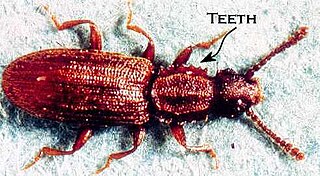 W
WOryzaephilus surinamensis, the sawtoothed grain beetle, is a beetle in the superfamily Cucujoidea. It is a common, worldwide pest of grain and grain products as well as chocolate, drugs, and tobacco. The species's binomial name, meaning "rice-lover from Surinam," was coined by Carl Linnaeus, who received specimens of the beetle from Surinam.
 W
WRats are various medium-sized, long-tailed rodents. Species of rats are found throughout the order Rodentia, but stereotypical rats are found in the genus Rattus. Other rat genera include Neotoma, Bandicota and Dipodomys.
 W
WThe red flour beetle is a species of beetle in the family Tenebrionidae, the darkling beetles. It is a worldwide pest of stored products, particularly food grains, and a model organism for ethological and food safety research.
 W
WThe rice weevil is a stored product pest which attacks seeds of several crops, including wheat, rice, and maize.
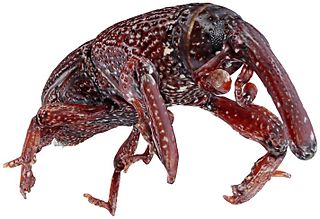 W
WThe wheat weevil, also known as the grain weevil or granary weevil, is an insect that feeds on cereal grains, and is a common pest in many places. It can cause significant damage to harvested stored grains and may drastically decrease crop yields. The females lay many eggs and the larvae eat the inside of the grain kernels.